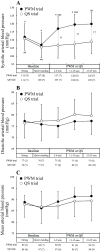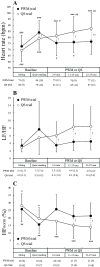Suppression of cardiocirculatory responses to orthostatic stress by passive walking-like leg movement in healthy young men
- PMID: 22971904
- PMCID: PMC3517532
- DOI: 10.1186/1880-6805-31-24
Suppression of cardiocirculatory responses to orthostatic stress by passive walking-like leg movement in healthy young men
Abstract
Background: Although passive walking-like leg movement in the standing posture (PWM) has been used in the clinical field, the safety of PWM has not been fully determined despite the risks of orthostatic intolerance due to standing posture. The aim of the present study was to examine cardiocirculatory response during PWM in healthy young men.
Methods: The subjects (n = 13) spent 5 min in a sitting position and then 5 min in a quiet standing position to determine baseline levels. Thereafter, they underwent 25-min rhythmic PWM at 1 Hz while standing. In another bout, subjects experienced the same protocol except that they underwent 25-min quiet standing (QS) instead of 25-min PWM. Two subjects dropped out of the 25-min QS due to feeling of discomfort. Thus, data obtained in the remaining eleven subjects are presented.
Results: In the PWM trial, systolic arterial blood pressure (SAP) decreased from 112 ± 8 mmHg during the sitting baseline period to 107 ± 8 mmHg during the standing baseline period (p <0.05), while heart rate (HR) increased from 73 ± 9 bpm during the sitting baseline period to 84 ± 10 bpm during the standing baseline period (p <0.001). After the imposition of PWM, SAP increased from 107 ± 8 mmHg in the standing baseline period to 120 ± 6 mmHg (p <0.001), while HR decreased from 84 ± 10 bpm in the standing baseline period to 76 ± 9 bpm (p <0.05). In the QS trial, SAP, which had decreased during the standing baseline period compared to that during the sitting baseline period, remained lowered during the 25-min QS period, while HR, which had increased during the standing baseline period compared to that during the sitting baseline period, remained elevated during the 25-min QS period. In both bouts, HR showed almost mirror-image changes in the high-frequency component of HR variability, suggesting that the changes in HR were due to change in parasympathetic activation. Double product (HR × SAP), as a predictor of myocardial oxygen consumption, during the 25-min QS period tended to increase with time, but double product remained almost constant during the 25-min PWM period.
Conclusions: The results suggest that PWM is effective for suppressing cardiocirculatory responses to orthostatic stress.
Figures




Similar articles
-
Higher ventilatory responses during and after passive walking-like leg movement in older individuals.J Physiol Anthropol. 2013 Nov 8;32(1):20. doi: 10.1186/1880-6805-32-20. J Physiol Anthropol. 2013. PMID: 24209769 Free PMC article.
-
Orthostatic testing for heart rate and heart rate variability monitoring in exercise science and practice.Eur J Appl Physiol. 2024 Dec;124(12):3495-3510. doi: 10.1007/s00421-024-05601-4. Epub 2024 Sep 11. Eur J Appl Physiol. 2024. PMID: 39259398 Review.
-
Unique cutpoints for sitting-to-standing orthostatic vital signs.Am J Emerg Med. 2003 Jan;21(1):45-7. doi: 10.1053/ajem.2003.50009. Am J Emerg Med. 2003. PMID: 12563580
-
The Effect of Acute Administration of the Aqueous Calyx Extract of Hibiscus sabdariffa on Blood pressure, Heart rate and Double Product of Apparently Healthy Human Subjects during Different Postures.Niger J Physiol Sci. 2022 Jun 30;37(1):147-152. doi: 10.54548/njps.v37i1.18. Niger J Physiol Sci. 2022. PMID: 35947852
-
Role of dangling when moving from supine to standing position.Br J Nurs. 2003 Mar 27- Apr 9;12(6):346-50. doi: 10.12968/bjon.2003.12.6.11241. Br J Nurs. 2003. PMID: 12682585 Review.
Cited by
-
Higher ventilatory responses during and after passive walking-like leg movement in older individuals.J Physiol Anthropol. 2013 Nov 8;32(1):20. doi: 10.1186/1880-6805-32-20. J Physiol Anthropol. 2013. PMID: 24209769 Free PMC article.
-
Effects of Gait Rehabilitation Robot Combined with Electrical Stimulation on Spinal Cord Injury Patients' Blood Pressure.Sensors (Basel). 2025 Feb 6;25(3):984. doi: 10.3390/s25030984. Sensors (Basel). 2025. PMID: 39943623 Free PMC article.
-
Walking for hypertension.Cochrane Database Syst Rev. 2021 Feb 24;2(2):CD008823. doi: 10.1002/14651858.CD008823.pub2. Cochrane Database Syst Rev. 2021. PMID: 33630309 Free PMC article.
References
-
- Fenton AM, Hammill SC, Rea RF, Low PA, Shen WK. Vasovagal syncope. Ann Intern Med. 2000;133:714–725. - PubMed
-
- Rowell LB. Human cardiovascular control. New York: Oxford University Press; 1993.
-
- Task Force of the European Society of Cardiology and the North American Society of Pacing and Electrophysiology. Heart rate variability. Standards of measurement, physiological interpretation, and clinical use. Eur Heart J. 1996;17:354–381. doi: 10.1093/oxfordjournals.eurheartj.a014868. - DOI - PubMed
Publication types
MeSH terms
LinkOut - more resources
Full Text Sources
Medical
Miscellaneous

